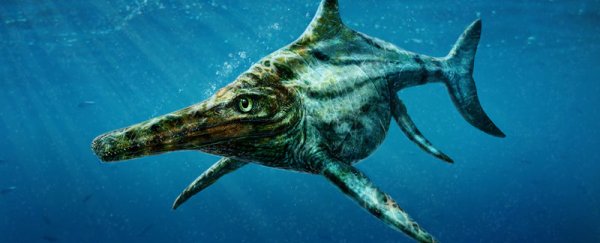Scientists in Scotland have uncovered the remains of the country's first known Jurassic sea reptile, which lived around 100 million years before T. rex.
But despite headlines around the world, the reptile most definitely is not the fabled Loch Ness Monster - in fact, the reptile looked more like a dolphin than a giant sea monster.
The fossils of the ancient reptile were discovered on the Isle of Skye, off the west coast of Scotland, by amateur fossil hunter Bryan Shawcross. They've been sitting in a museum in Glasgow unnoticed for the past 50 years - until palaeontologist Stephen Brusatte from the University of Edinburgh decided to classify the remains.
The genus name, Dearcmhara — pronounced "jark vara" — is the Scottish Gaelic word for marine lizard. (Scottish Gaelic is a traditional language for residents of Skye.)
The discovery of the species has now been described in the Scottish Journal of Geology, and Brusatte and his team have named it Dearcmhara shawcrossi - with the species name in honour of Shawcross, and the genus name meaning "marine lizard" in Scottish Gaelic.
And you'd be forgiven for calling the motorboat-sized reptile a dinosaur - despite the fact it belongs to a class of boss-like marine creatures called ichthyosaurs.
"It looks like a dinosaur, but it isn't technically a dinosaur," Brusatte told Joe Palca at NPR. " Dinosaurs didn't live in the ocean." The fact that it's an ichthyosaur, which Brusatte describe over at The Conversation as "top dogs in the oceans when dinosaurs ruled the land", is even cooler.
"It's the first one of these sea-living, enormous, colossal, top-of-the food-chain reptiles that's ever been found in Scotland," Brusatte told Palca.
D. shawcrossi was around 4 to 4.5 metres long (14 to 15 feet), and the researches believe that it was one of many Jurassic reptiles that swam in the waters around Scotland around 170 million years ago. Their next mission is to find more fossils from the time, which isn't particularly well-represented in the fossil record
To do this, Brusatte writes over on The Conversation that they need the help of other amateur fossil hunters - just like Shawcross - especially those who will donate their finds to research, rather than selling them on eBay or to other collectors.
"We want to figure out what Scotland was like during the Middle Jurassic, this mysterious interval of time from which so few fossils are known around the world. What animals lived here? What were their ecosystems like? How did they evolve over time?" writes Brusatte.
"We hope the story of Brian Shawcross resonates across Scotland: there are fossil beasts to be found, so get up and go outside, and if you find something and it's new, please donate it to a museum and work with us to get it identified and studied. After all, I think that having a unique new 170-million-year old fossil named after you is much better than making a few quid on eBay."
Sources: The Conversation, NPR
